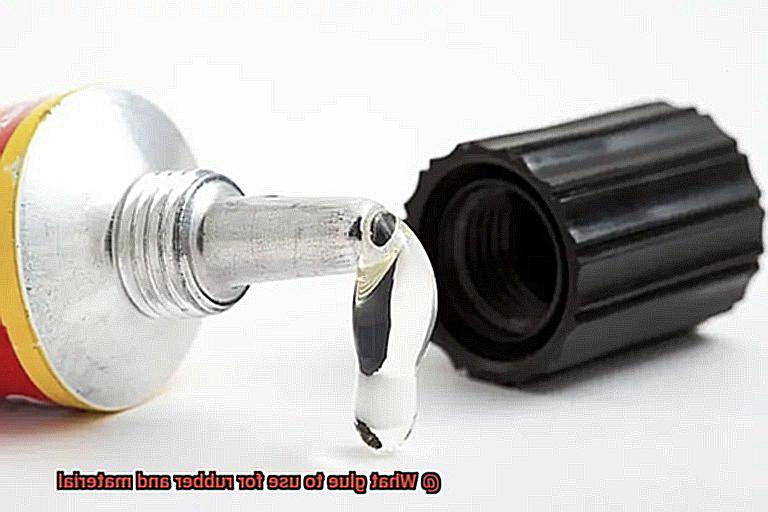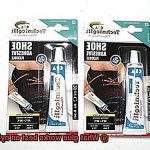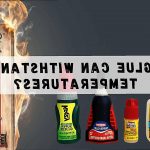Welcome to our blog post, where we’ll explore the fascinating world of adhesives and uncover the perfect glue for bonding rubber and other materials. Whether you’re a DIY guru, a craft aficionado, or a professional in need of an adhesive you can rely on, it’s crucial to find the right glue for your projects. Don’t be fooled by its seemingly simple nature – not all adhesives are created equal, and using the wrong one can lead to weak or failed bonds.
When it comes to bonding rubber and materials together, there are several glues available, each with their own unique perks and downsides. In this article, we’ll dive into some of the most popular options, shedding light on their effectiveness, versatility, and compatibility with different materials.
First up is cyanoacrylate adhesive – also known as super glue. This powerful adhesive is excellent for bonding rubber to plastic or even rubber to rubber. Its lightning-fast setting time makes it ideal for small and precise projects. However, take note that while super glue boasts impressive bond strength, it may struggle to penetrate certain materials like fabric or porous surfaces.
If you’re working primarily with fabrics or porous materials like leather, then fabric glue (also called fabric adhesive) is your go-to option. This specially designed glue creates flexible and durable bonds that are perfect for clothing repairs or crafting accessories. However, keep in mind that fabric glue may not be the best choice when it comes to bonding rubber since it lacks the necessary strength and compatibility.
Moving on to polyurethane glue – commonly known as PU glue – this adhesive is a crowd favorite for bonding rubber and various other materials such as wood, metal, or ceramic. It forms strong and flexible bonds that can withstand extreme conditions like temperature changes or exposure to moisture. Just remember that PU glue usually takes longer to cure and might not be ideal for intricate projects due to its foaming properties.
Last but not least, we have epoxy resin. Renowned for its versatility and incredible bond strength, epoxy is a top choice for bonding rubber, metal, plastic, glass, and many other materials.
Its ability to fill gaps and create strong adhesive layers, coupled with its resistance to heat, chemicals, and water, makes it a go-to option for countless applications.
However, keep in mind that working with epoxy often requires proper surface preparation and precise mixing.
Types of Glue for Bonding Rubber and Material
Contents
- 1 Types of Glue for Bonding Rubber and Material
- 2 Contact Cement: Advantages and Disadvantages
- 3 Cyanoacrylate Adhesive (Super Glue): Advantages and Disadvantages
- 4 Epoxy Adhesive: Advantages and Disadvantages
- 5 Rubber Cement: Advantages and Disadvantages
- 6 Silicone-Based Adhesives: Advantages and Disadvantages
- 7 Tips for Choosing the Right Glue for Bonding Rubber and Material
- 8 Importance of Following Manufacturer Instructions
When it comes to bonding rubber and other materials together, choosing the right type of glue is crucial for ensuring a strong and durable bond. There are several types of glues available in the market that are specifically designed for bonding rubber and various materials. Let’s take a closer look at some of the most commonly used glues for this purpose.
- Cyanoacrylate Glue (Super Glue): Cyanoacrylate glue, commonly known as super glue, is a popular choice for bonding rubber to various materials. This adhesive forms a strong bond quickly and is known for its high strength and resistance to moisture, heat, and chemicals. However, not all super glues are suitable for bonding rubber. Look for a cyanoacrylate glue that is specifically formulated for rubber bonding.
- Silicone Adhesive: Silicone adhesive is another excellent option for bonding rubber and material. This type of glue is flexible, waterproof, and resistant to extreme temperatures, making it ideal for applications where flexibility and durability are required. Silicone adhesive forms a strong bond between rubber and different materials such as metal, plastic, fabric, and glass.
- Epoxy: Epoxy adhesives are widely used for bonding rubber to various materials due to their exceptional strength and versatility. Epoxy consists of two components – a resin and a hardener – that need to be mixed together just before application. Once mixed, epoxy adhesive creates a durable bond that is resistant to water, chemicals, heat, and impact. Choose an epoxy adhesive that is specifically formulated for rubber bonding.
- Polyurethane Adhesive: Polyurethane adhesives are known for their excellent bonding properties on a wide range of materials including rubber. This type of glue forms a strong bond that is resistant to water, heat, chemicals, and impact. Polyurethane adhesive is flexible, making it suitable for bonding rubber to materials with different degrees of flexibility.
- Contact Cement: Contact cement is commonly used for bonding rubber to various materials in applications such as shoe repair and upholstery. This adhesive forms a strong bond when both surfaces are coated with the glue and allowed to dry before pressing them together. Contact cement provides a quick and reliable bond, but follow the manufacturer’s instructions for proper application and curing time.
It is essential to keep in mind that not all glues are suitable for all types of rubber or materials. It is always recommended to read the manufacturer’s instructions and test the glue on a small area before proceeding with the actual bonding process. Additionally, factors such as surface preparation, cleanliness, and proper application technique also play a crucial role in achieving a successful bond between rubber and other materials.
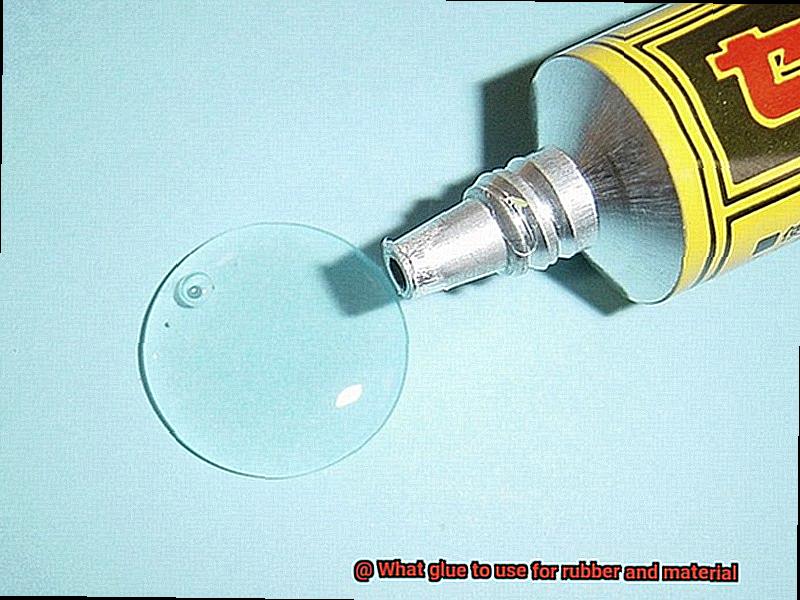
In conclusion, there are several types of glues available for bonding rubber and material. Cyanoacrylate glue, silicone adhesive, epoxy, polyurethane adhesive, and contact cement are some of the commonly used options. Each type of glue has its own unique properties and advantages, so choose the right glue based on the specific requirements of your project.
Contact Cement: Advantages and Disadvantages
Contact cement is a highly effective adhesive commonly used for bonding rubber and materials together. It offers a range of advantages, including its strong bond, versatility, and easy application. However, it also has some disadvantages, such as its strong odor, limited repositioning, and long drying time.
One of the key advantages of contact cement is its ability to create a strong bond between rubber and material. It forms an instant, permanent bond that is resistant to heat, water, and chemicals. This makes it ideal for applications where a reliable and durable bond is required. Additionally, contact cement is highly versatile and can be used to bond a wide range of materials, including rubber, leather, wood, metal, and plastic. This versatility makes it a go-to adhesive for many DIY projects and professional applications.
Another advantage of contact cement is its easy application. It comes in either liquid or gel form and can be applied with a brush, roller, or spray gun. Both surfaces need to be coated with the cement and allowed to dry before they are pressed together to form the bond.
However, contact cement does have some disadvantages. Firstly, it has a strong odor due to the volatile solvents it contains. This can be unpleasant and potentially harmful if used in poorly ventilated areas. It is recommended to use contact cement in well-ventilated spaces or wear protective masks when working with it.
Additionally, once contact cement has been applied and the surfaces have been pressed together, it creates an instant bond that is difficult to reposition. Unlike some other adhesives that allow for adjustments before setting, contact cement requires accurate alignment from the start.
Lastly, contact cement has a relatively long drying time compared to other adhesives. It can take anywhere from 15 minutes to several hours for the cement to fully dry and create a strong bond. This can be a disadvantage for projects that require quick bonding or immediate use.
Cyanoacrylate Adhesive (Super Glue): Advantages and Disadvantages
Cyanoacrylate adhesive, commonly known as super glue, is a versatile and popular choice for bonding rubber and various materials. It offers several advantages that make it a go-to adhesive for many applications. One of its main advantages is its quick curing time. Unlike other adhesives that require hours to set, cyanoacrylate adhesive forms a strong bond within seconds. This fast-drying property saves valuable time and allows for efficient bonding of rubber and other materials.
In addition to its rapid curing, super glue is known for its high strength. It creates a durable bond that can withstand significant stress and tension. This makes it an ideal choice for applications where a strong and reliable bond is required, such as in automotive repairs or crafting projects. Its ability to hold up under pressure ensures that the bond will remain intact over time.
Furthermore, cyanoacrylate adhesive offers versatility in bonding different materials. Whether it’s rubber, plastic, metal, ceramics, or more, super glue can effectively bond a wide range of surfaces. This convenience makes it a practical choice for various bonding needs, as it eliminates the need for multiple types of adhesives.
Another advantage of super glue is its resistance to moisture. Unlike some adhesives that weaken or lose their bond in wet conditions, cyanoacrylate adhesive remains strong even when exposed to water or humidity. This makes it suitable for applications where moisture may be present, such as in bathroom repairs or outdoor projects.
However, there are also some disadvantages to consider when using cyanoacrylate adhesive. One drawback is its brittleness. While it provides a strong bond, super glue can be prone to cracking or breaking under extreme pressure or impact. This means it may not be suitable for applications where flexibility or resistance to impact is required.
Another limitation of cyanoacrylate adhesive is its limited gap-filling capabilities. It works best when the surfaces being bonded fit together tightly. Gaps or uneven surfaces may result in weaker bonds. Therefore, it may be necessary to use other types of adhesives for applications that require filling larger gaps or bonding uneven surfaces.
Additionally, super glue can be difficult to remove once it is fully cured. Accidental spills or excess glue may require specialized solvents or techniques to effectively remove. This can be a challenge, especially if the adhesive is on a delicate or sensitive surface.
It’s important to note that cyanoacrylate adhesive may not be suitable for all types of rubber. Certain types, such as silicone or fluorosilicone, may not bond well with super glue. It is recommended to test the adhesive on a small area or consult the manufacturer’s guidelines before proceeding with the bonding process.
In terms of cost, cyanoacrylate adhesive is generally affordable and readily available in various sizes and forms, making it accessible for both small-scale and large-scale projects.
From an environmental perspective, cyanoacrylate adhesive is considered safe and does not release harmful chemicals into the air or water. However, it should still be used with caution and kept out of reach of children.
Epoxy Adhesive: Advantages and Disadvantages
Epoxy adhesive is a versatile and strong bonding option for rubber and other materials, but it does come with its fair share of advantages and disadvantages.
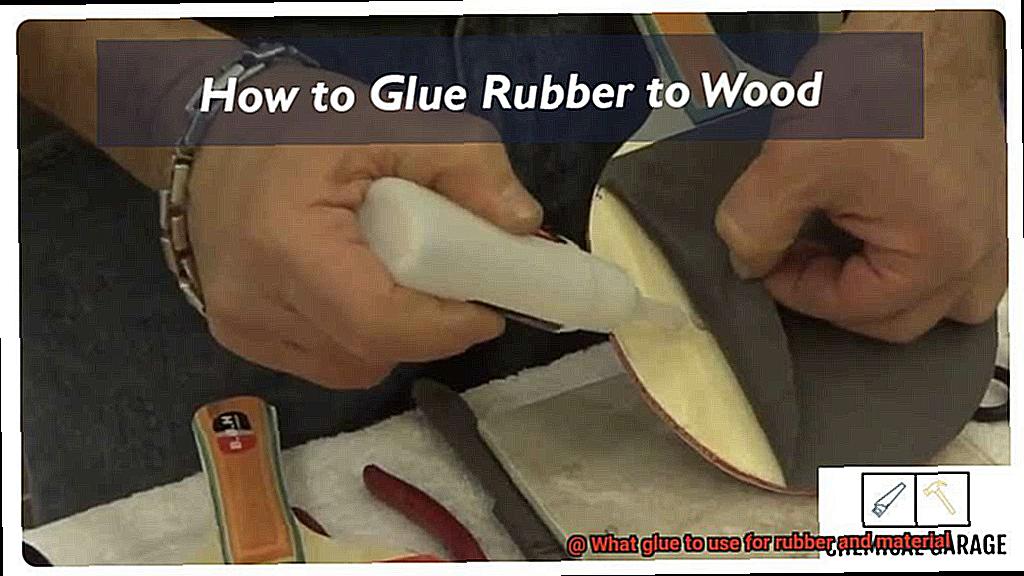
Advantages:
- Exceptional Bonding Strength: Epoxy adhesive forms a powerful and enduring bond between rubber and various materials like metal, wood, ceramic, and plastic. This ensures a secure and long-lasting bond, making it perfect for applications that require reliability.
- Versatility: Epoxy adhesive can be used on a wide range of rubber materials, including natural rubber, synthetic rubber, neoprene, and silicone rubber. This flexibility makes it suitable for industries such as automotive, construction, electronics, and manufacturing.
- Chemical Resistance: Epoxy adhesive offers excellent resistance to chemicals and solvents. It can withstand exposure to oils, fuels, acids, bases, and other harsh substances without compromising its bonding strength. This is especially crucial in industries where rubber components face corrosive agents.
- Temperature Tolerance: Epoxy adhesive can withstand extreme temperatures without losing its bonding properties. Whether in scorching heat or freezing cold, it remains reliable. This makes it ideal for applications in environments with temperature fluctuations.
Disadvantages:
- Longer Curing Time: Epoxy adhesive requires adequate time to cure and reach its maximum strength. Depending on the formulation and conditions, it may take several hours or even days. This can be a drawback in situations that demand fast assembly or production turnaround times.
- Complex Application Process: Epoxy adhesive typically involves precise mixing of resin and hardener in specific ratios for proper curing. Improper mixing can result in weak bonds or incomplete curing. Additionally, epoxy adhesives have a limited pot life once mixed, requiring them to be used within a specific timeframe.
- Higher Cost: The advanced properties and performance characteristics of epoxy formulations can make them more expensive compared to other adhesives. This could be a deciding factor for projects with budget constraints that prioritize cost-effectiveness.
Rubber Cement: Advantages and Disadvantages
Rubber cement is a popular adhesive used for bonding rubber and other materials together. It offers several advantages that make it a preferred choice in many applications. Here are the advantages of rubber cement:
- Strong and Durable Bond: Rubber cement forms a flexible and resilient bond that allows for movement and stretching without compromising the adhesive strength. This makes it suitable for applications where flexibility is required, such as in rubber shoes or inflatable toys.
- Versatility: Rubber cement can be used with various types of rubber, including natural rubber, synthetic rubber, and latex. It can also bond rubber to different materials like fabric, wood, metal, and plastic. This versatility makes it ideal for a wide range of projects, from repairing shoes to crafting and DIY projects.
- Easy Application: Rubber cement usually comes in liquid form, allowing for precise application using a brush or applicator. The liquid consistency ensures even spreading over the surfaces to be bonded, resulting in a uniform and seamless bond. Additionally, rubber cement has a relatively fast drying time, allowing projects to be completed quickly.
However, rubber cement also has some disadvantages that should be considered:
- Strong Odor: Rubber cement contains volatile solvents that evaporate during the drying process, releasing a distinct smell that some people find unpleasant or irritating. Proper ventilation is necessary when working with rubber cement to minimize exposure to these fumes.
- Limited Resistance to Heat and Moisture: Rubber cement may not be suitable for applications where the bonded materials will be subjected to high temperatures or excessive moisture. Over time, exposure to these conditions can weaken the bond created by rubber cement, causing it to become brittle or break apart.
- Difficult Removal: Once dried, rubber cement forms a rubbery consistency that is challenging to remove from surfaces. Care must be taken during application to avoid spills or excess adhesive, as any mistakes should be promptly cleaned up before the cement dries.
Silicone-Based Adhesives: Advantages and Disadvantages
Silicone-based adhesives are highly versatile and offer numerous advantages when it comes to bonding rubber and other materials. First and foremost, these adhesives provide excellent adhesion to a wide range of materials including rubber, plastics, metals, glass, and ceramics. This versatility makes them suitable for various applications in industries such as automotive, electronics, and construction.
One of the key advantages of silicone-based adhesives is their flexibility. Unlike many other types of adhesives, silicone-based adhesives remain flexible even after curing. This flexibility allows for the expansion and contraction of bonded materials without compromising the bond strength. This is particularly beneficial when bonding rubber, known for its elasticity. The ability of silicone-based adhesives to withstand movement and vibration without losing adhesion makes them ideal for applications that require durability and long-term performance.
Another advantage is their resistance to temperature extremes. Silicone-based adhesives can withstand both high and low temperatures without losing their adhesive properties. This heat resistance makes them suitable for applications in automotive engines or outdoor settings where temperature fluctuations are common. Additionally, they offer excellent electrical insulation properties, making them ideal for bonding electrical components.
Silicone-based adhesives also exhibit excellent resistance to moisture and chemicals. They create a waterproof seal that prevents moisture from penetrating the bond line, protecting the integrity of the bond and the materials being bonded. Their chemical resistance ensures that the adhesive will not break down or degrade when exposed to various chemicals, enhancing the longevity of the bond.
However, silicone-based adhesives do have some disadvantages to consider. One drawback is their relatively slow curing time compared to other types of adhesives. This can limit their use in applications where quick bonding or fast production cycles are required.
Another disadvantage is their higher cost compared to other adhesive options. The materials used in silicone-based adhesives tend to be more expensive than those used in other formulations. Although they offer unique benefits, the higher cost may deter some applications, especially when more cost-effective alternatives are available.
Additionally, silicone-based adhesives may not provide the same bond strength as certain solvent-based or epoxy adhesives. While they offer excellent adhesion to a wide range of materials, silicone-based adhesives may not be the best choice for applications that require extremely high bond strength.
Tips for Choosing the Right Glue for Bonding Rubber and Material
When choosing the right glue for bonding rubber and material, it is important to consider the specific type of rubber and material you are working with. Different glues work better on different types of rubber and materials, so it is crucial to match the right glue with the right materials.
One important factor to consider is the flexibility of the bond required. Rubber is a flexible material, so it is important to choose a glue that can withstand stretching and movement without compromising the bond. Look for glues that are specifically designed for flexible bonds or have flexibility as one of their properties.
Another factor to consider is the surface compatibility of the glue. Some glues may not adhere well to certain types of rubber or materials due to their chemical composition or surface characteristics. It is always recommended to test the glue on a small, inconspicuous area before applying it to the entire surface.
Adhesive strength is another crucial aspect to consider. Depending on the application, you may need a strong adhesive that can withstand heavy loads or vibrations. Make sure to choose a glue that has a high bonding strength and is suitable for your specific bonding needs.
Temperature resistance is also an important consideration. If the bonded rubber and material will be exposed to extreme temperatures, such as in automotive or outdoor applications, it is important to choose a glue that can withstand these conditions. Look for glues that offer high-temperature resistance for durability and longevity.
Ease of use should also be taken into account. Some glues require special mixing or curing processes, while others come in convenient forms such as tapes or adhesives with applicators. Consider your level of expertise and the specific requirements of your project when choosing a glue that is easy to handle and apply.
Finally, consider any specific requirements or regulations for your project. For example, if you are working on a project that requires food-grade materials, make sure to choose a glue that is approved for such applications. Also, consider any environmental regulations or restrictions that may apply, and choose a glue that is eco-friendly if necessary.
Importance of Following Manufacturer Instructions
Crafting strong and durable bonds requires more than just the right glue; it also involves following the manufacturer instructions. These instructions are not to be taken lightly – they hold the key to optimal performance, safety, and warranty protection. So, before you embark on your bonding journey, take a moment to understand the importance of adhering to the instructions:
- Optimal Performance: Manufacturers invest valuable time and resources into developing their glue products. Through rigorous research and testing, they determine the best application methods, drying time, and other crucial factors. By following their instructions, you unlock the full potential of the glue and ensure that it performs at its best.
- Strong Bonds: Different glues possess unique properties tailored for specific applications. By heeding the manufacturer’s instructions, you can confidently select the right glue for rubber and material bonding. This guarantees that your bonds will be robust and long-lasting.
- Surface Preparation: Don’t underestimate the power of proper surface preparation. Manufacturer instructions often contain vital information about prepping the surface before applying the adhesive. Skipping or neglecting this step can compromise the bond’s strength, leading to weak bonds or catastrophic failure.
- Recommended Temperature Range: Glue behaves differently under varying temperature conditions. The manufacturer instructions will usually provide a recommended temperature range for optimal bonding. Disregarding this range can jeopardize the bond’s strength or cause it to fail altogether.
- Application Techniques: Applying glue is an art in itself, and the manufacturer knows best. Their instructions will guide you on the best techniques for applying the glue, whether it involves using a specific tool or employing a particular method. Following these techniques ensures that the adhesive is evenly distributed and applied effectively.
- Curing Times: Patience is indeed a virtue when it comes to glue bonding. Manufacturer instructions specify the required curing times for the glue to reach its maximum strength. Rushing this process can result in weak bonds or premature failure, so be sure to give your bonds the time they need to solidify.
- Safety First: Manufacturer instructions often contain safety guidelines, such as proper ventilation requirements, recommended protective equipment, and handling precautions. It’s imperative to follow these guidelines to safeguard yourself from any potential health hazards or accidents.
- Warranty and Guarantee: The manufacturer stands behind their product, but not if you neglect their instructions. Failure to follow the manufacturer instructions may void any warranty or guarantee associated with the glue. So, if you encounter any bonding issues, don’t expect assistance or compensation if you haven’t followed the prescribed guidelines.
- Consistent Results: Deviating from the recommended procedures introduces variables that may affect the outcome of your bonds. By faithfully adhering to the manufacturer instructions, you can achieve consistent and reliable results every time.
- Trust the Experts: Even if you consider yourself a glue guru, remember that each glue product has its unique characteristics and requirements. Trusting in the expertise of the manufacturer ensures that you’re harnessing the full potential of their product and achieving the best possible bonding results.
5ecE-EiZruY” >

